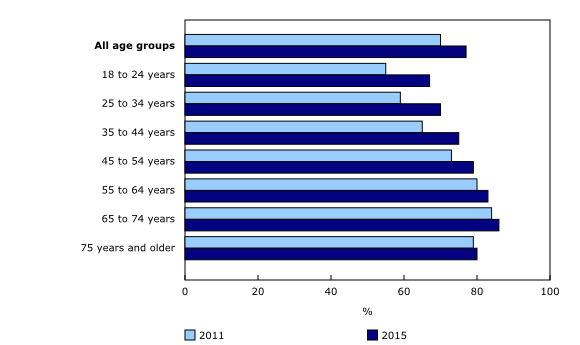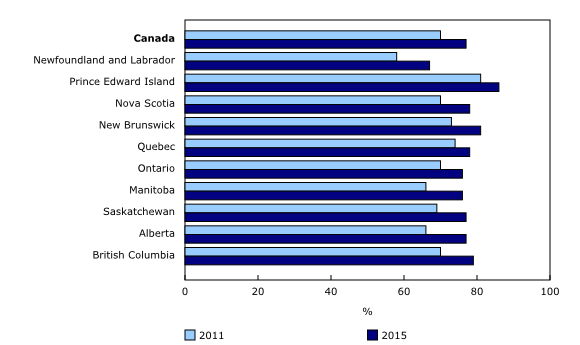Reasons for not voting in the federal election, October 19, 2015
Archived Content
Information identified as archived is provided for reference, research or recordkeeping purposes. It is not subject to the Government of Canada Web Standards and has not been altered or updated since it was archived. Please "contact us" to request a format other than those available.
Released: 2016-02-22
A higher proportion of Canadians reported that they had voted in the 2015 federal election (77%) compared with 2011 (70%), with the largest increase among younger voters. Among people aged 18 to 24, the voter turnout rate increased from 55% in 2011 to 67% in 2015, and among those aged 25 to 34, it rose 11 percentage points to 70%.
Among the 23% of eligible Canadians voters who reported that they did not vote in the October 2015 federal election, the most common reason reported for not voting was 'not being interested in politics,' followed by being 'too busy.'
There were no notable differences in the reasons for not voting between men and women in the 2015 federal election. The reasons for not voting were also similar for Aboriginal and non-Aboriginal people. However, there were differences across age groups, regions and immigrant statuses.
Overall, Prince Edward Island (86%) had the highest proportion of respondents who reported having cast a ballot in the October 2015 federal election, while Newfoundland and Labrador (67%) reported the lowest. Compared with 2011, voter turnout rates increased in all provinces, led by Alberta (+11 percentage points) and Manitoba (+10 percentage points). Quebec reported the smallest increase (+4 percentage points).
By immigrant status, the largest increase was among immigrant Canadians with citizenship who had been in Canada for 10 years or less, as their turnout rate went up from 56% to 70%. The turnout rate for immigrant Canadians with citizenship who had been in Canada for more than 10 years increased from 71% to 76%. Among Canadian-born citizens, the rate also increased, up from 70% to 78%.
One in three non-voters reports not being interested in politics
The single largest reason provided for not voting was 'not being interested in politics,' with 32% of non-voters giving this as the reason for not casting a vote in the October 2015 federal election. This held true for all age groups between the ages of 18 and 64. For those aged 75 and older, 18% of non-voters reported not being interested in politics as a reason for not voting.
Canadian-born citizens were most likely to report a lack of interest in politics (34%) as a reason for not voting, compared with 25% of immigrants with citizenship who had been in Canada for more than 10 years.
Everyday life or health reasons commonly reported for not voting
In almost half of all cases (48%), non-voters cited everyday life or health reasons as a cause for not casting a ballot. These reasons included being too busy (23%), being out of town (12%), or having an illness or disability (12%).
Canadians aged 25 to 34 (30%) and aged 35 to 44 (30%) were the most likely to indicate that they did not vote because they were too busy.
Residents of Ontario (25%), Manitoba (25%) and Saskatchewan (25%) were the most likely to report being too busy to vote. On the other hand, those from Newfoundland and Labrador (18%) and Nova Scotia (19%) were the least likely to report that reason.
The proportion of those who did not cast a vote because of an illness or disability was higher among the older age groups, ranging from 14% for those aged 55 to 64, to more than 50% for those aged 75 or older.
Youth most likely to report reasons related to the electoral process
During the 2015 federal election, 8% of non-voters identified reasons related to the electoral process as the cause for not voting. This included reasons such as not being able to prove one's identity or address, or not being on the voters list.
Younger Canadians were more likely to report not voting because of electoral process issues than those in older age groups. Among those aged 18 to 24 years, 11% reported not voting for these reasons.
Note to readers
Data for this study were derived from five questions added to the November 2015 Labour Force Survey (LFS), commissioned by Elections Canada, to determine the reasons Canadians did not vote in the October 19, 2015, federal election.
These questions were:
- Are you a Canadian citizen?
- Did you vote in the recent federal election?
- Why did you not vote?
- Did you go to a polling station and try to vote? (if the survey respondent answered "could not prove identity or address" to question 3)
- In the past 12 months, did you use Elections Canada's online service to check, update or complete your voter registration?
The question 'Why did you not vote?' included 17 categories that were divided into four broad groups for this publication. Because of quality issues for some data, the following categories have not been discussed in this study in detail:
Political reasons: Lack of information about campaign issues and parties' positions; did not like candidates/parties/campaign; felt voting would not make a difference; did not know whom to vote for.
Electoral process-related reasons: Could not prove identity or address; not on voters list; transportation problem / polling station too far; lack of information about the voting process; lines were too long; issues with the voter information card.
All other reasons: Forgot to vote; religious or other beliefs; other reasons.
Eligible voters as defined in this study exclude people aged 18 and older who were not Canadian citizens, including "permanent residents" (landed immigrants) who had not yet obtained Canadian citizenship and "non-permanent residents" (people from another country who lived in Canada and had a work or study permit, or who were claiming refugee status, as well as family members also living in Canada with them) at the time of the survey.
Previous studies and post-elections surveys have consistently shown that voter turnout rates reported in those studies are higher than official voter turnout rates. The estimate for the voter turnout rate in this special LFS study (77.0%) was 8.5 percentage points higher than the official figure published by Elections Canada (68.0%) following the October 19, 2015, federal election. In a similar survey conducted following the 2011 federal election, the turnout rate from the survey was 70.0%, 8.6 percentage points higher than the official figure of 61.4% published by Elections Canada.
As the question on reasons for not voting was changed between 2011 and 2015, data for the two periods are not comparable.
Contact information
For more information, contact us (toll-free 1-800-263-1136; 514-283-8300; STATCAN.infostats-infostats.STATCAN@canada.ca).
To enquire about the concepts, methods or data quality of this release, contact Jeremy Weeks (613-951-1369; jeremy.weeks@canada.ca), Labour Statistics Division.
- Date modified:



